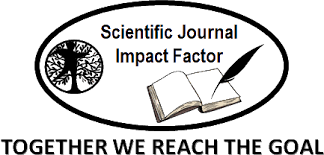Design, Synthesis of new imidazole derivatives as potential antibacterial agents
Keywords:
Schiff base, Imidazole, Resistance, ThiadiazolAbstract
In this study, heterocyclic compounds stabilized on benzoamidazole were prepared by reacting 5-((1H-imidazol-1-yl)methyl)-1,3,4-thiadiazol-2-amine with various aromatic aldehydes, including 1H-indole-3-carbaldehyde and [1,1'-biphenyl], new Schiff's base derivatives a1-a5 have been created.4-(methylthio)benzaldehyde, 4-(phenoxymethyl) benzaldehyde, 1-naphthaldehyde, and 4-carbaldehyde. in ethanol at 80 °C with glacial acetic acid acting as a catalyst in a good yield. All compound's antimicrobial qualities were examined. The bulk of the compounds are shown to be the most effective against applicable bacterial strains, according to a review of the biological activity data. The compounds (a1 and a3) exhibited the best inhibition against strains of S. aureus and E. coli. This makes it important to note that Schiff's base derivatives including imidazole and nuclei have emerged as a key field of antibacterial research. These derivatives could be a solution to many problems if they are worked on and developed by researchers.
References
Woodford, N. (2003). Novel agents for the treatment of resistant Gram-positive infections. Expert
opinion on investigational drugs, 12(2), 117-137.
Li, Z. L., Li, Q. S., Zhang, H. J., Hu, Y., Zhu, D. D., & Zhu, H. L. (2011). Design, synthesis and
biological evaluation of urea derivatives from o-hydroxybenzylamines and phenylisocyanate as
potential FabH inhibitors. Bioorganic & medicinal chemistry, 19(15), 4413-4420.
Lee, J. Y., Jeong, K. W., Shin, S., Lee, J. U., & Kim, Y. (2009). Antimicrobial natural products as
β-ketoacyl-acyl carrier protein synthase III inhibitors. Bioorganic & medicinal chemistry, 17(15),
-5413.
-J. Zhang, H., -L. Li, Z., & -L. Zhu, H. (2012). Advances in the research of β-ketoacyl-ACP
synthase III (FabH) inhibitors. Current Medicinal Chemistry, 19(8), 1225-1237.
Khandekar, S. S., Daines, R. A., & Lonsdale, J. T. (2003). Bacterial β-ketoacyl-acyl carrier protein
synthases as targets for antibacterial agents. Current Protein and Peptide Science, 4(1), 21-29.
Tsay, J. T., Oh, W., Larson, T. J., Jackowski, S., & Rock, C. O. (1992). Isolation and
characterization of the beta-ketoacyl-acyl carrier protein synthase III gene (fabH) from Escherichia
coli K-12. Journal of Biological Chemistry, 267(10), 6807-6814.
Heath, R. J., & Rock, C. O. (1996). Regulation of fatty acid elongation and initiation by Acyl-Acyl
carrier protein in Escherichia coli (∗). Journal of Biological Chemistry, 271(4), 1833-1836.
Christensen, C. E., Kragelund, B. B., von Wettstein‐Knowles, P., & Henriksen, A. (2007). Structure
of the human β‐ketoacyl [ACP] synthase from the mitochondrial type II fatty acid synthase. Protein
science, 16(2), 261-272.
Li, H. Q., Shi, L., Li, Q. S., Liu, P. G., Luo, Y., Zhao, J., & Zhu, H. L. (2009). Synthesis of C (7)
modified chrysin derivatives designing to inhibit β-ketoacyl-acyl carrier protein synthase III (FabH)
as antibiotics. Bioorganic & medicinal chemistry, 17(17), 6264-6269.
Puupponen‐Pimiä, R., Nohynek, L., Meier, C., Kähkönen, M., Heinonen, M., Hopia, A., &
Oksman‐Caldentey, K. M. (2001). Antimicrobial properties of phenolic compounds from
berries. Journal of applied microbiology, 90(4), 494-507.
Luo, Y., Zhang, L. R., Hu, Y., Zhang, S., Fu, J., Wang, X. M., & Zhu, H. L. (2012). Synthesis
and Antimicrobial Activities of Oximes Derived from O‐Benzylhydroxylamine as FabH
Inhibitors. ChemMedChem, 7(9), 1587-1593.
Brusic, V., & Petrovsky, N. (2005). Immunoinformatics and its relevance to understanding human
immune disease. Expert review of clinical immunology, 1(1), 145-157.
Uto, Y., Nagasawa, H., Jin, C. Z., Nakayama, S., Tanaka, A., Kiyoi, S., ... & Hori, H. (2008).
Design of antiangiogenic hypoxic cell radiosensitizers: 2-Nitroimidazoles containing a 2-
aminomethylene-4-cyclopentene-1, 3-dione moiety. Bioorganic & medicinal chemistry, 16(11),
-6053.
Luo, Y., Li, H. Q., Zhou, Y., Li, Z. L., Yan, T., & Zhu, H. L. (2010). Metronidazole–
Deoxybenzoin Derivatives as Anti‐Helicobacter pylori Agents with Potent Inhibitory Activity against
HPE‐Induced Interleukin‐8. ChemMedChem, 5(7), 1110-1116
Qin, Y. J., Wang, P. F., Makawana, J. A., Wang, Z. C., Wang, Z. N., Jiang, A. Q., & Zhu, H. L.
(2014). Design, synthesis and biological evaluation of metronidazole–thiazole derivatives as
antibacterial inhibitors. Bioorganic & medicinal chemistry letters, 24(22), 5279-5283.
Soedin, K., Syukran, O. K., Fadillah, A., & Sidabutar, P. (1985). Comparison between the
efficacy of a single dose of secnidazole with a 5-day course of tetracycline and clioquinol in the
treatment of acute intestinal amoebiasis. Pharmatherapeutica, 4(4), 251-254.
Zhang, H. J., Qin, X., Liu, K., Zhu, D. D., Wang, X. M., & Zhu, H. L. (2011). Synthesis,
antibacterial activities and molecular docking studies of Schiff bases derived from N-(2/4-
benzaldehyde-amino) phenyl-N′-phenyl-thiourea. Bioorganic & medicinal chemistry, 19(18), 5708-
Lee, J. Y., Jeong, K. W., Lee, J. U., Kang, D. I., & Kim, Y. (2009). Novel E. coli β-ketoacyl-acyl
carrier protein synthase III inhibitors as targeted antibiotics. Bioorganic & Medicinal
Chemistry, 17(4), 1506-1513.
Li, Y., Zhao, C. P., Ma, H. P., Zhao, M. Y., Xue, Y. R., Wang, X. M., & Zhu, H. L. (2013).
Design, synthesis and antimicrobial activities evaluation of Schiff base derived from secnidazole
derivatives as potential FabH inhibitors. Bioorganic & medicinal chemistry, 21(11), 3120-3126.
Lv, P. C., Sun, J., Luo, Y., Yang, Y., & Zhu, H. L. (2010). Design, synthesis, and structure–
activity relationships of pyrazole derivatives as potential FabH inhibitors. Bioorganic & medicinal
chemistry letters, 20(15), 4657-4660.
Fahad, M. M., Shafiq, N., Arshad, U., & Radh, A. J. (2021). As Antimicrobial Agents: Synthesis,
Structural Characterization and Molecular Docking study of Barbituric Acid Derivatives from
Phenobarbital. Chemical Methodologies 6:122-136.
Ehab K. Obiad, Ahmed Thamer Salim, Ali Jabbar Radhi, Tahseen Talib Mohsen, Bashaer Jawad
Kahdum (2024) Green Synthesis, Molecular Docking Studies, and Antimicrobial Evaluation of
Tetrazoles Derivatives, Asian Journal of Green Chemistry, 8(6), 762–778.
Radhi, A. J., Zimam, E. H., & Jafer, E. A. (2021). New barbiturate derivatives as potent in vitro
α-glucosidase inhibitors. Egyptian Journal of Chemistry, 64(1), 117-123.
Radhi, A. W., Zimam, E. H., & Radhi, A. J. (2022, January). Synthesis and study thermal
properties of some new maleimide polymers contain sulfa drugs. In American Institute of Physics
Conference Series (Vol. 2386, No. 1, p. 030018).
CLSI (2008) Clinical, Laboratory Standards Institute. Reference method for broth dilution
antifungal susceptibility testing of filamentous fungi, 2nd edn. CLSI, Wayne.
Kumaravel G, Raman N (2017) A treatise on benzimidazole based Schiff base metal(II)
complexes accentuating their biological efficacy: spectroscopic evaluation of DNA interactions,
DNA cleavage and antimicro bial screening. Mater Sci Eng C 70:184–194.
Mateus A, Gordon LJ, Wayne GJ et al (2017) Prediction of intracellular exposure bridges the gap
between target- and cell-based drug discovery. Proc Natl Acad Sci 114:E6231–E6239.
Mai-Prochnow A, Clauson M, Hong J, Murphy AB (2016) Gram positive and Gram negative
bacteria differ in their sensitivity to cold plasma. Sci Rep 6:38610.
Downloads
Published
How to Cite
Issue
Section
License

This work is licensed under a Creative Commons Attribution-NonCommercial 4.0 International License.











